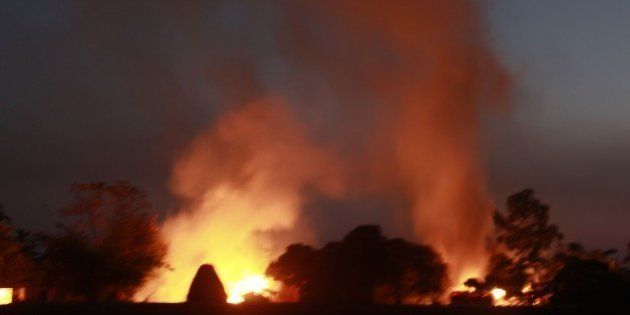
Security forces are battling militants belonging to NDFB(S), accused of Tuesday's carnage in Assam. The encounter is taking place near the border with Bhutan, TV reports said.
NDFB (S) is a breakaway faction of the National Democratic Front of Bodoland (NDFB). The leader of the group, I.K. Sonbijit, is said to be based in Myanmar and controlling his operations from there.
The death toll in the carnage rose to 81 after more bodies were found even as the army chief Gen. Dalbir Singh Suhag met Home Minister Rajnath Singh to discuss ongoing operations in the violence-hit region. Tensions between Bodo and non-Bodo tribes remained rife, with potential for more deaths as tribals sought revenge.
The army has deployed helicopters to track down Bodo terrorists who might flee towards Bhutan, as they have done in the past.
"We have 66 companies and will definitely intensify our operations," General Suhag said after the meeting. Singh has asked for swift action by the army to catch the fleeing NDFB militants. "We cannot overlook it as a simple militant act. It is an act of terror. Both state and central governments will deal with it the way terrorism is dealt with," Singh said. More than 3,000 troops are on the ground for operations against NDFB(S). Singh has also sought cooperation from Bhutan and Myanmar governments to combat the group.
Violence continued as the tribals targeted Bodo homes in retaliation of the carnage. Bodo tribal groups rule Bodoland but they make up only 38 percent of the population. Non-Bodos, including Muslims and other tribals, are questioning this structure as they aspire for a greater share of political power. In parliamentary elections in May, a non-Bodo won from Kokrajhar, scene of the latest killings.
Apart from the killings by Bodos, three tribals were killed when police fired on a protest march last week. Four Bodos were killed by non-Bodo tribals in a revenge attack in Manikpur and Dimapur areas. Over 10,000 people have taken shelter in relief camps since the killings.
Prime Minister Narendra Modi has condemned the killing of innocent people as an act of cowardice, and announced Rs. 2 lakh each for the family members of the killed.
The killings are seen as retribution by militants who suspected that tribals were informing security forces about their movements. Over the weekend, the police killed two Bodo militants and recovered a cache of arms during a counterterrorism raid. The armed forces have stepped up their focus on Bodos in the last few months.
This is not the first such act by Bodo militants, although the victims are from a different community. Earlier attacks by Bodos tended to target Muslims, including those who speak Bengali and are seen by Bodo tribes as illegal migrants. Tensions between the two communities have been simmering for years. In May, Bodo militants killed 32 Muslims in a brutal attack.
That came after the worst phase of violence in 2012, when clashes between Bodos and Muslims led to 78 deaths. Over 300,000 were displaced and became refugees in their own country. Ever since that time, various ethnic groups in the Bodoland area, formed after a peace deal between militants and the government, have been polarized.